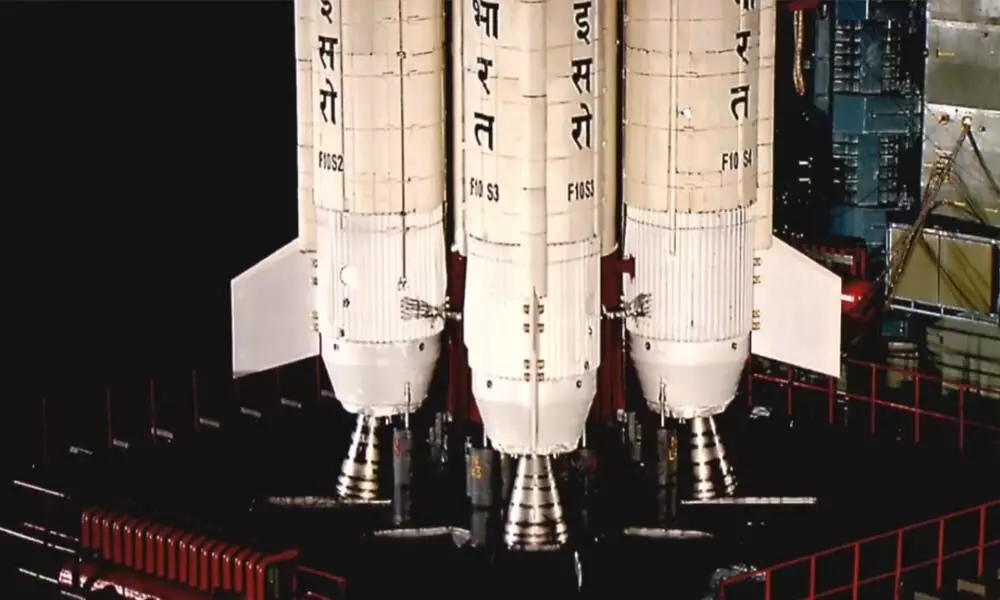GSLV 'naughty boy' image stays as it plays truant again
At about six minutes into the rocket’s flight and soon after the cryogenic engine started operation, the mission control centre at the spaceport here tensed up as there was no data coming from the rocket
image for illustrative purpose

INDIA's rocket Geosynchronous Satellite Launch Vehicle (GSLV) continues to be a naughty boy, it seems.
The rocket earned the nickname after some failed missions earlier. Later it started performing well.
However, that seemed to have changed on Thursday morning when the GSLV-F10 was on its way to put into orbit the Geo-Imaging Satellite-1 (GISAT-1) renamed as Earth Observation Satellite-03 (EOS-03). Everything went off well as planned till the cryogenic engine got fired at about five minutes into the rocket's flight.
At about six minutes into the rocket's flight and soon after the cryogenic engine started operation, the mission control centre at the spaceport here tensed up as there was no data coming from the rocket. The rocket was seen deviating from its plotted path on the screen.
One of the ISRO officials announced that there was a performance anomaly in the cryogenic engine.
Then the ISRO officials realised the mission had failed. After that K Sivan, Chairman, ISRO said: "The mission cannot be fully accomplished because of a technical anomaly observed in the cryogenic stage."
India presently has three fully operational rockets -- the Polar Satellite Launch Vehicle (PSLV) and two GSLV variants -- GSLV-Mk II with a carrying capacity of 2.5 tonnes and GSLV-MkIII with a payload capacity of four ton.
Including Thursday's rocket a total of 18 GSLVs (Mk I, II and III) have been flown of which twelve were successful, six failures (four a total failure and two partial). The 12 successful launches were in 2003, 2004, 2007, 2014, 2015, 2017, 2018 and 2019 when the rocket launched GSAT-2, Edusat/GSAT-3 an educational satellite, INSAT-4CR, GSAT-14, GSAT-6, GSAT-9, GSAT-6A, GSAT-7A, GSAT-19, GSAT-29, Chandrayaan-2 and one experimental flight (GSLV-MkIII) in 2014. The ISRO officials had dubbed GSLV in general as naughty boy owing to its unpredictable performance. It took quite some time for ISRO to stabilise its 'naughty boy' GSLV-Mk II rocket with a carrying capacity of 2.5 ton.
The GSLV rocket's maiden flight in 2001 (Mark I) was a partial failure as it was not able to sling GSAT-1 into the intended orbit. The satellite could not be raised to the intended orbit later.
The 2006 was sort of an historic flight for a dubious reason. For the first time ISRO destroyed the rocket mid-air soon after the lift off as it started backing up.
However the 2007 flight gave anxious moments to ISRO officials. Fifteen seconds before the lift-off, the rocket's computers put GSLV on hold, detecting anomalies in the cryogenic fuel stage.
The launch was postponed by two hours to set right the problem even as ISRO officials were considering rescheduling the launch by another two days. However, the detection of one of the vent valves in the cryogenic engine that had not shut properly led to its immediate rectification.
That apart, ISRO scientists were on tenterhooks till the last moment as for a few seconds during the final cryogenic stage signals from the rocket failed to reach the ground stations.
After a three year gap ISRO flew a GSLV in April 2010 with its own cryogenic engine. The mission failed due to the problem in the cryogenic engine's fuel booster turbo pump.
Another GSLV went down in December 2010 after it veered off its designated path and exploded mid-air. For the second time a GSLV rocket was destroyed mid-air for safety purpose.

